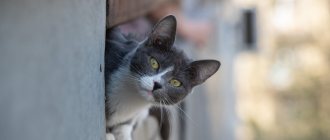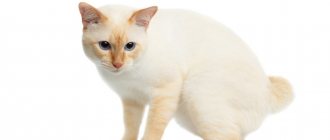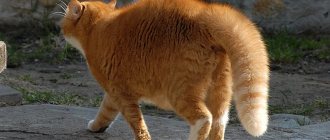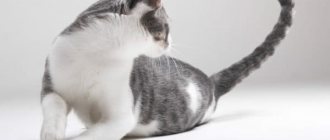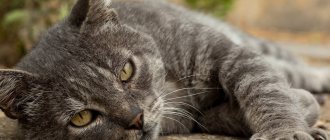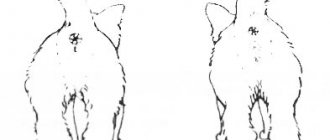Everyone knows that the tail
- This is not only a decoration for a cat. It helps to successfully land on the ground or floor when jumping from a height, to balance fearlessly on fences and tree branches, coordinating the balance of the animal. And the tail of mustachioed pets is a real mood indicator. Unable to express their emotions through words, our smaller brothers use body language. And, perhaps, the movements of a cat’s tail can demonstrate to the owner what the animal is experiencing, more eloquently than any meow.
What does a cat wagging its tail want to tell us?
An animal's mood changes many times during the day, just like any person. To determine a cat’s mood by its tail, just watch it:
Photo: Cat | Dreamstime.com
- The cat’s tail is directed upward, the hair on it stands on end, the back is arched, the eyes are widened - the animal is in a state of extreme anger (perhaps there is an object of the pet’s hostility nearby: a strange cat, dog);
- Standing or sitting, the cat swings its tail chaotically, hitting the floor or its own sides with force - the pet is extremely unfriendly and is even capable of launching an attack. This “behavior” of the tail can be observed, for example, after a cat meets an opponent or after games that are unpleasant for the animal (throwing the pet up to the ceiling, actively stroking the belly, etc.);
- The cat shakes its tail quickly and shallowly, pointing it upward - a sign of excitement, including sexual excitement. This behavior can be noticed in a cat when it sees an individual of the opposite sex or is in anticipation of its favorite treat;
- The cat presses itself to the ground or floor, lowering its tail, the tip of which twitches finely and nervously - a signal that the hunting instinct has awakened in the pet (there is a rodent, bird, insect nearby);
- The cat wags its tail not too actively - a sign that the purr is considering its actions, for example, deciding whether to have a snack now or go for a walk;
- The pet has its tail pointed upward, perpendicular to its back - a good sign that means the animal is in good position. With their tails up and purring, friendly cats greet their owner returning from work;
- While sitting, the pet actively wags the tip of its tail, looking interestedly at one point - a sign that the animal is currently in a playful mood. This behavior of a cat can be seen while tracking a toy mouse on a string;
- The cat sits, looking into the eyes of the owner, and its tail wags along the floor at medium speed - the animal’s attempt to attract attention (“master, look at me”);
- The tail is fluffed and lowered down, the paws are slightly tucked - this means that the pet is scared (for example, by a vacuum cleaner suddenly turned on or by an unknown person coming into the house);
- The cat sits, stands or lies, and its tail is in a calm state - a sign of peace and good mood;
- The cat waves its tail, raising it horizontally - an action that means that the animal is wary and mistrustful. This happens if a family friend has not finally decided that he is safe (for example, if he came to someone else’s yard or ended up in a veterinary clinic);
- The pet's tail is directed vertically, and the tip is slightly bent - a good sign indicating that the animal is in a calm mood;
- The cat went to a place of rest and even dozed off, but its tail, nevertheless, slowly moves from side to side - a signal that the animal is worried about something, is nervous and does not feel safe. Such a sight can be observed, for example, if the animal is irritated due to loud noises in the room or on the street;
- The pet's head in a standing position is lowered down, the tail hangs indifferently and relaxed between the paws - the pet Murzik makes it clear that he is sad or bored;
- The pet almost falls on the owner’s legs, wrapping his tail around them - a clear sign of flattery. So an animal can beg for food or call for affection;
- A cat with its tail raised up and slightly bent at the tip approaches the owner and lightly bites his leg - an attempt to attract attention (“master, don’t forget to play with me” or “feed me)”;
- A domestic friend pokes his head at his owner, raising his tail vertically - a sign of love and friendship. Usually cats behave this way only with the people they like the most and never with strangers.
Cat tail device
The tail of animals is an extension of their spine.
According to the anatomical description, it consists of three parts - base, stem and tip. The average length of a cat's tail is 25 cm, for cats this figure is approximately 28 cm, however, in the Guinness Book of Records there is a mention of the longest-tailed domestic cat - its length of this part of the body is neither more nor less, but as much as 41.5 cm. It may include a different number of vertebrae, depending on the length - from 19 to 28. They are oval in shape, connected by cartilage tissue and braided with muscles. In the middle of the vertebrae there are openings through which the spinal canal passes. The tip of the tail includes from 5 to 7 vertebrae, the last of which is not always fully developed or is pointed.
Thanks to the thickened intervertebral cartilages, the tail has a certain flexibility. Each cavity between the vertebrae has a plexus of nerve endings. You don't have to be a veterinarian to know that a cat's tail is an extremely sensitive part of the body.
How can you tell how a cat is feeling by its tail?
By the movement of the tail, you can not only understand the cat’s mood, but also learn something about the animal’s well-being and behavior, and even predict the weather:
Photo: Cat | Dreamstime.com
- If a cat approaches a wall (door, furniture), raises its tail horizontally and quickly shakes it, this may mean that the animal has “marked” its territory. This behavior can occur not only in males, but also in females;
- When a cat is quietly dozing or just sitting and resting, its tail is usually at rest. But as soon as you name the pet’s name, the animal instantly responds to the owner’s voice with a slight wag of its tail. The cat seems to say: “Master, I hear you”;
- Typically, sharp, chaotic movements of the tail symbolize the rage of the animal. But not always. Sometimes a pet who is not feeling well shakes its tail vigorously;
- A cat sometimes wags its tail due to stress (change of place of residence, rearrangement of furniture, appearance of a new pet in the house, etc.);
- The animal may twitch its tail and occasionally chew it due to the presence of fleas or other bloodsuckers;
- If a pet tucks its tail under itself while sitting or lying down, it means it is cool. There is even such a belief: a cat curls up and hides its tail between its paws - frost will come soon. By the way, this is not the only folk sign about a cat’s tail. It is believed that an animal can fluff its tail before a snowstorm, and lick it thoroughly before rain;
- When a furry pet lies down on the floor with its tail parallel to its back, it means it’s hot.
Why does a cat need a tail?
The tail is very important for any cat, whether wild or domestic:
- The tail helps maintain balance. Cats climb excellently on various surfaces - balconies, roofs, trees, jump from considerable heights and often fall. During the flight, they maneuver with all parts of the body and especially with the tail, and almost always the animal manages to land on 4 paws. Such abilities allow a cat to fall not only from the 2nd or 3rd floors, but also from the 5th-6th and higher, and the flight ends not in death, but in a slight fright. And the tail plays an important role in the ability not only to jump perfectly, but also to land correctly. It allows the cat to walk on narrow cornices, thin branches, and successfully balance.
- Tail-rudder. The same part of the body serves as a rudder when the animal runs; the cat can turn sharply and change its running trajectory, and the tail is able to transfer the center of gravity. This greatly helps wild brothers during hunting. You can see that large felines such as tigers, leopards, and lions have tails that differ in length and thickness. And this is not without reason, since they use it with might and main while chasing prey and when long jumps are required. Yes, cats have no equal in this.
- It warms and cools. But the tail is not only steering and balancing, but also a temperature regulator. Often during the summer heat you can find a pet lounging imposingly in the shade, raising its tail up and swaying it rhythmically... In a similar way, a cat tries to cool down, controlling, as far as possible, air currents, creating a breeze, a fan works in the same way. In cool weather, cats like to curl up into balls, thus minimizing heat transfer. In this case, the tail wraps around the body, and the animal sticks its muzzle into it. It turns out that the animal uses its own warm fur coat to warm the coldest areas - the nose and paws.
- The tail helps in sorting out relationships. As you know, cats sort out relationships between their own kind quite harshly. Yes, they do not fight so often, but they actively use other methods - a shrill voice, back and tail. Usually the winner is the loudest male, who has the most arched back with menacingly raised hair and a fluffy tail.
- Landmark in the dark. Along with the whiskers, the tail helps cats navigate in the dark.
- Tail toy. All owners of cats with tails (naturally, we are not talking about cats without tails) will confirm that not a single toy or entertainment can replace your own tail. They play from birth until old age, never ceasing to look at him in surprise. In addition, mother's tail is the first toy of funny babies.
- Tail indicator. You can easily guess a cat's mood just by looking at its tail. Of course, a tailless cat can jump, and its fall does not always end in tragedy. However, it is more difficult for her to maintain balance, and the jump length is much shorter. Cats, naturally deprived of a tail, are better adapted, but even those animals that lose this part of the body by tragic accident adapt quite quickly to new conditions. But in this case, the owners will no longer be able to guess the pet’s mood by the position of its tail. Other owners have the opportunity to do this.
Other emotions
The tail will also tell you about other features of the cat’s mood. Let's see what else his movements say .
- A thoughtful wagging of the tip of the tail - something attracted the cat's attention. She listens, sniffs, looking for an object that interests her, and moves her tail to the beat of her “reflections.” At such moments it becomes like a question mark.
- Calm wiggles while playing with the owner demonstrate her good disposition and pleasure from having fun together. However, during gameplay the cat may begin to cross the boundaries of permitted behavior. This will be noticeable by the accelerating movements of the tail, which may be followed by painful bites and scratches on the person.
- Cats wag their tails vertically when they are either sexually aroused or want to play.
- When a cat, instead of waving its tail, taps it on the floor with small nervous movements, this means that it is not just nervous, but is experiencing stress. Also, tapping often indicates that your pet is in pain. Having noticed that the cat began to wag its tail in this way, the owner needs to be alert and provide assistance to the animal.
Some owners notice that the cat constantly wags its tail when dozing. Smooth, gradually subsiding movements indicate that the animal is comfortable, it feels safe and is gradually going to sleep. Having fallen soundly asleep, cats sometimes also begin to twitch their tail. Scientists believe that they dream and react to them in a similar way. Having noticed such body movements in a sleeping pet, the owner need not worry - his pet is simply “chasing” another mouse in his sleep.
© shutterstock
How else can a cat “talk”?
The tail is not the only way a cat can show its attitude. Animals have quite a lot of visual aids: ears, paws, and the whole body. Quite often they convey information using sound signals.
Interesting!
Tailless cat breeds are becoming increasingly popular. Now there are several dozen of them. Some are already recognized as felinologists, others are just winning their hearts. The owners of such pets claim that the absence of a fifth limb does not interfere with their mutual understanding.
The human-cat dictionary can be supplemented with the following sections.
Communication using the body
Cat conversations can involve the whole body. With the help of movements, the animal is able to convey all important information and clarify details “left unsaid” by the tail.
| Gesture | Image | Designation |
| “I’m interested”, “I’m listening to you” | ||
| “I am completely happy, calm and content” | ||
| “There’s danger somewhere nearby, but I’m on my guard.” | ||
| “I acknowledge your superiority”, “I’m bored” | ||
| “I love you”, “I want to please you” | ||
| “You are only mine”, “Stroke me” | ||
| “I trust you completely”, “I love you” | ||
| “I need your attention”, “Stroke me” | ||
| “I feel danger, but I want to avoid a fight”; “Let’s resolve everything peacefully or I can’t vouch for myself” | ||
| "I will fight" |
Communication using glances
Eyes also play a huge role in dialogue. By studying the cat's language of views, you can not only learn to understand your pet, but also respond to him in such a way that he understands.
Why do cats shake their tail?
Watching the cat, breeders wonder why the cat develops new behavioral characteristics - the tail is shaking. To give an accurate answer, you need to understand the details of this phenomenon.
A restless cat holds his tail in a horizontal position. If a cat's tail occasionally trembles and he looks around in fear, with his ears pressed to his head, this indicates the animal's alertness. If there is an object of irritation in the room, then it should be removed from the cat’s field of view, otherwise the animal may panic, and the further outcome of the actions of a frightened animal is unpredictable.
Note! But if the tail sways from side to side, you need to be prepared for a sudden attack by your pet, however, such a command from a pet does not always foreshadow a threat. Similar habits can be observed while playing with an inanimate object.
Cats, parading their ancestors, attack their toy.
Cats, like humans, can express doubt when they need to make a choice. Living for several thousand years side by side with people, the descendants of tigers began to adopt some of the habits of the supreme being. While in thought, a person can rhythmically tap his fingers on the table or swing his leg. Likewise, a cat, which is faced with a choice, begins to involuntarily twitch the tip of its tail; the pussy holds the base of the tail straight. Moreover, in such a situation, only the tail is involved, that is, no other peculiarities in the cat’s behavior are observed. To stop flinching, you just need to help your pet make a choice.
The cat also twitches its tail, expressing a feeling of satisfaction. When the cat is calm, fed, and happy, he slowly raises the tip of his tail up and down. Also, such behavior indicates reciprocal feelings for the owner’s affection, so a representative of the cat family expresses gratitude to a person, and the cat purrs and, perhaps, rubs against the owner’s hands, walks around the owner. In addition, by twitching its tail, the cat informs others that what is happening in the room completely satisfies it.
Often the reason for a wagging tail is interest.
Movements of the tail are carried out slowly and to the beat, but the general appearance of the animal remains unchanged, all the cat’s attention is focused on one object. This usually happens after the owner goes to the store; in such a situation, the subject of the cat’s examination becomes a bag of food.
A pet, showing interest in something, watches with caution, sniffs, carefully examines the object, sometimes engrossed in its occupation, and prevents the owner from passing.
Note! To accurately determine why your beloved cat's tail is shaking, you need to be attentive to details, namely, the environment in which the animal is located, the general appearance of the cat and the pet's surroundings at the moment.
What tail problems do cats have?
Bald spot on a cat's tail
The thickness of the hair on the tail is used to judge the health of the animal. If he begins to go bald, you should take the animal for examination. Baldness can be a consequence of dermatitis, disruption of the cat’s digestive system, allergies and other diseases. Frequent stressful situations also lead to hair loss on the tail. To establish a diagnosis, you need to show your pet to a doctor, take a blood test and scrape the epithelium from the site of the lesion.
Owners are concerned about their pet's tail being eaten. This is usually done by kittens that are taken away from a cat early. The objects of sucking are soft toys, blankets, and sweaters of the owner, but if they cannot be reached, the pet sucks its own tail. At the age of 1.5–2 years, the habit of sucking something will disappear, so there is no reason to worry.
The most common problem with the tail is injury. The cause of injury can be poor treatment of the animal, when the owners allow themselves or their children to grab the pet by this organ. The tail can be damaged by accidentally stepping on it or being crushed by a door.
Delaying treatment is dangerous for your pet's health. A large number of nerve endings converge in the tail; it is connected to the spine, so injury to it can lead to malfunctions of the entire body.
What does it mean when a cat wags its tail?
Everyone knows that the tail
- This is not only a decoration for a cat. It helps to successfully land on the ground or floor when jumping from a height, to balance fearlessly on fences and tree branches, coordinating the balance of the animal. And the tail of mustachioed pets is a real mood indicator. Unable to express their emotions through words, our smaller brothers use body language. And, perhaps, the movements of a cat’s tail can demonstrate to the owner what the animal is experiencing, more eloquently than any meow.
Why you shouldn't pull your pet's tail
The cat should not be pulled by the thin tail vertebrae. According to popular belief, the pet will begin to defecate in the wrong corners. In reality, these actions are cruel, physically unpleasant for the animal, cause discomfort, and often cause injury and illness.
A bully, grabbing a cat wagging its tail, can injure the vertebrae, requiring surgical assistance or amputation.
Often hooligan actions lead to paralysis of the hind limbs and urinary incontinence in the pet.
Cats are vengeful, tugging and squeezing - which means humiliation of dignity - does not forgive, they begin to take revenge.
How to determine your mood by your tail
During the day, your pet experiences a wide range of emotions.
It’s easy to determine a cat’s mood by looking at its tail. To understand body language, it is enough to carefully observe the animal: The cat raises its tip, bends it, and at the same time begins to purr - hints about the desire to remain alone and alone
The mood is neutral, the animal is tired of attention. A cat in a sitting position peers at the owner, slowly wagging the end part of the appendage to the right and left - attracts attention. A process raised above the floor at an angle, meaning that the animal is thinking about its next actions, is alarming. It’s impossible to guess what an energetic cat will do: jump on the curtain, pee in his shoes. The pet bent down to the floor, ears pricked up
The reason why a cat excitedly twitches its tail is an awakened hunting instinct. The gaze fell on the potential victim. The cat purrs sweetly, squints his eyelids, rolls over on his back when being stroked, smoothly waves his tail tip - a manifestation of calm, bliss, and the highest degree of trust. The cat is tired of petting - the purring stops, the tail beats become sharp, and the amplitude increases. The animal opens its eyelids and glances displeasedly at the stroking palm, hinting that it’s time to stop. The dozing cat twitched on the lounger - she felt discomfort and sensed danger. Perhaps loud noises in the home, outside the window, were disturbing. The cat sat down with his back to his owner, exposing and raising his precious organ - not a sign of contempt, but a manifestation of complete trust. The cat leans against the owner's shin, wraps its tail vertebrae - trying to beg for a treat, affection. The pet, slightly bending the raised tip, approaches the owner, slightly bites the shin - trying to attract attention, remind them of the need to feed and play.
The caudal spine is a way of balancing, coordinating movements and communicating. By observing how a cat's tail twitches and trembles, it is easy to determine its mood and physical condition. Cat body movements are more eloquent than meowing, helping the owner to establish contact with the animal.
Needs for development of intelligence
Don't be afraid of pets chasing their tails. Cats are allowed to hunt for parts of their body at a young age. If the game lasts for a long time, you should ask a specialist about possible developmental disorders.
To develop your pet's intelligence, you can invite him to play special games. They will help the animal acquire the skills necessary for hunting. Toys can help your pet.
Types of toys popular among cats:
- feathers attached to a holder;
- bells on a cord;
- beanbag;
- a toy filled with catnip;
- interactive games on a tablet.
shutterstock
If games do not help and the animal continues to run in circles after its tail, you should think about a mental disorder.

